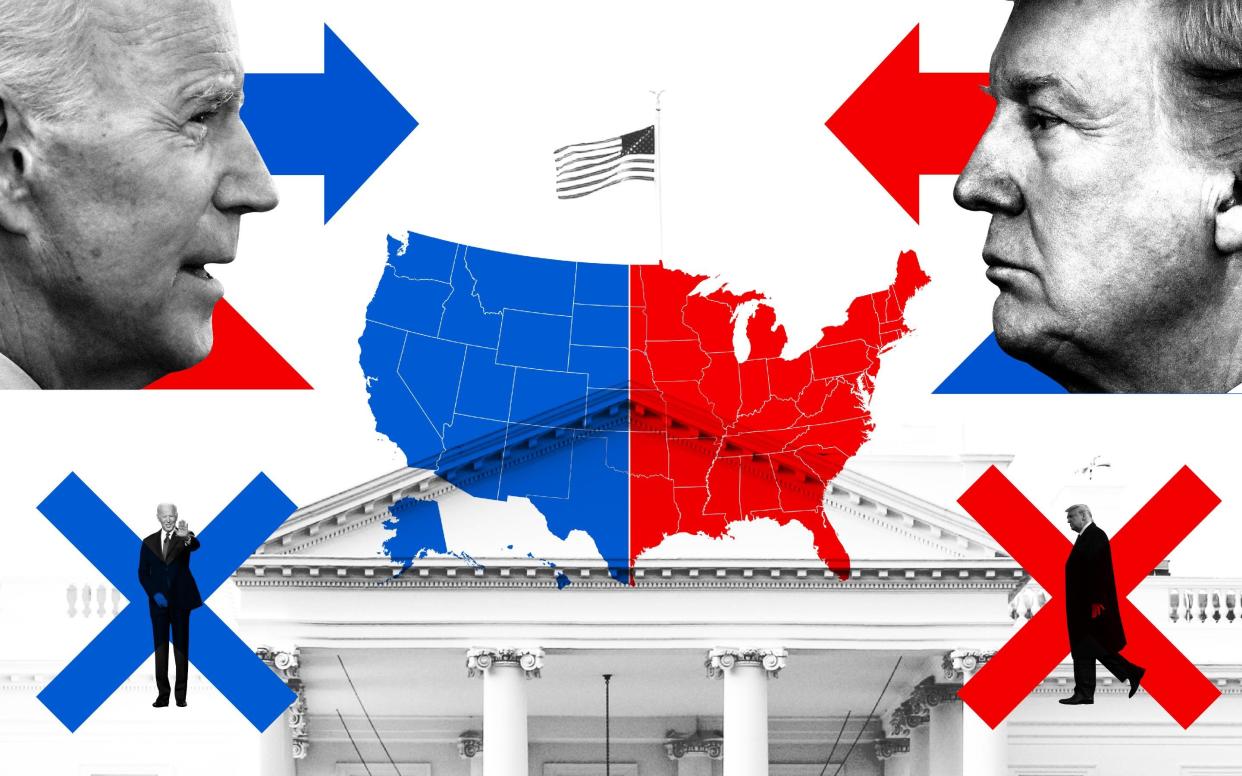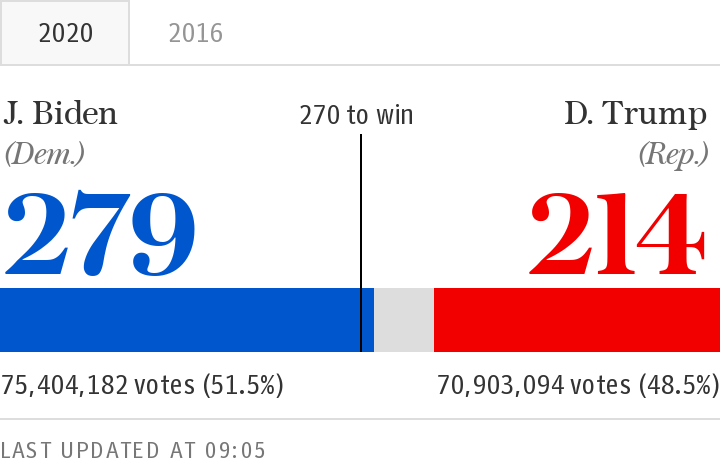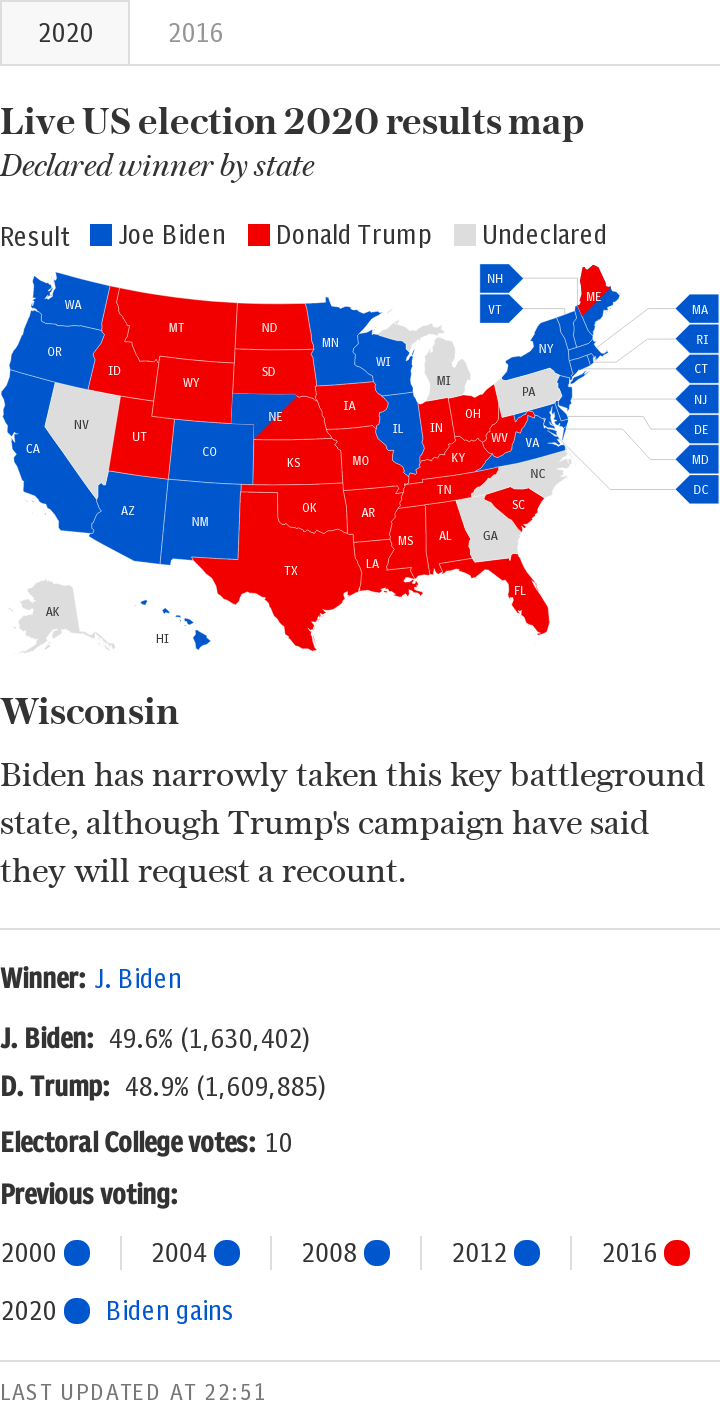US election results and maps 2020: Michigan win for Biden narrows Trump’s path to victory

- Oops!Something went wrong.Please try again later.
- Oops!Something went wrong.Please try again later.

Joe Biden has won Michigan, bringing a possible victory in the 2020 US presidential election tantalisingly close.
The two candidates are locked in a neck and neck race for the White House that might not have a clear winner for days, but the announcement of the Michigan and Wisconsin results put Biden within touching distance of the 270 electoral college votes needed to win.
The so-called 'Rust Belt' states have proved pivotal in the final stretch of a tighter-than-expected election, after an early Trump win in Florida hit Biden's chances of a landslide and limited his potential path to victory.
A further win in any of the states that are still to declare (except Alaska) will push Biden over the top. Of those, Nevada and Pennsylvania are seen as possibilities, although counting in both states is not expected to be finished for some time, maybe even days. He might also make it to 270 by winning in the previously Republican state of Georgia, which would echo his flipping this time round of Arizona from red to blue.

However Trump cannot be counted out - he may yet get his second term if he takes Pennsylvania, Georgia, Nevada and North Carolina.
The vast majority of races in the 2020 US election have called, going as predicted, but the final result may not become clear for some days.
Counts in states including Georgia and Nevada were eventually paused in the early hours of the morning, while the unprecedented number of mail-in ballots has presented a challenge across the nation.
During the delay, both sides signalled their belief that they would ultimately emerge victorious. Speaking from the White House’s East Wing after results started coming in, President Trump claimed “we were getting ready to win this election. Frankly, we did win this election.”
Hours later, Biden delivered a speech in which he stated that “I’m not here to declare that we’ve won, but when the count is finished, we believe we will be the winners.”
As election night unfolded, betting markets had moved in favour of a Trump victory, with improved odds for the sitting President standing in stark contrast to his predicted prospects from the day prior.
Final polling on November 3 had indicated Biden had the best chance of winning, leading Donald Trump nationally on average by 8.4 per cent at last reading, more than double Hillary Clinton’s lead by election day in 2016.
Yet closer than expected races in the key swings states mean negative polling and dire predictions for Trump may have vastly underestimated his chances of a shock victory.
With the benefit of hindsight pundits may point to the President's approval ratings barely shifting despite a tumultuous year and core support for his economic and migration policies as signs Trump would again prove the victorious underdog.
Results in key states are still expected - check this page regularly to see the latest results as and when they come in.
The key swing states left to watch
All 50 states and the District of Columbia voted in Tuesday's election. To win a candidate needs at least 270 of the 538 votes on offer in the US’s indirect voting system - the electoral college - where candidates pick up votes by coming first in a state and getting its proportional share of the total. Victory in California, population of 39.5m, earns you 55 electoral college votes, while winning Wyoming, home to 580,000, gets you three.
Pennsylvania, Wisconsin and Michigan have been the three key states to watch, but results did not come through on election night. They are part of America’s ‘Rust Belt’ - a region hit hard by industrial decline - and were key to Trump’s victory in 2016. If Biden wins all three while keeping a grip on the states won last time by Clinton, he’s likely on course for the presidency.

Georgia and North Carolina are a further two swing states yet to be declared. A striking feature of pre-election polling is it had suggested Biden could claim victory in states which have historically been Republican strongholds.

Initial results however suggested Biden had underperformed compared to polling, but nonetheless still had a shot at victory.
When will we get the final result?
Unlike most presidential races, we did not receive a decisive result on the night of the election, as officials in the remaining battlegrounds grappled with a large number of early votes.
Most states began counting mail-in ballots and those turning out to stations early before election day, but in several others - including key swing states like Pennsylvania and Wisconsin - laws prevent ballots from being checked until election day itself.
Combine these barriers with a tight race and then the Biden or Trump campaigns considering forcing recounts, and it’s possible to see how it might be some time before we know for sure who’s won.
In 2016 Donald Trump’s surprise victory was clear by about 3.30am to 4am GMT on election night following a string of swing states declaring in his favour and making his win all but certain. He officially crossed the 270 threshold at around 7.30am GMT.
How the 2020 campaign played out
Dominated by the spread of Covid-19, the 2020 presidential race has been far from traditional.
While Trump continued encouraging mass rallies the length and breadth of the country, Biden began the year with a more muted tone, cancelling in-person rallies and turning to virtual town halls and fundraisers.
Key rust-belt battleground states of Pennsylvania and Michigan have seen the most campaign visits from the two candidates, with Trump holding around double the number of events as the former Vice President since February.
With 15 rallies in Pennsylvania and 13 in North Carolina by the final day of the campaign, the incumbent has been targeting states he narrowly flipped from the Democrats in 2016 in the hope of a replay of the result four years ago.
But in terms of spending it is Biden who has expended the most - with vast TV and online advertising campaigns. To date, Biden has outspent his opponent by $1.40 to every dollar spent by Trump.
Turnout and the electoral college
Two of the last five presidential elections have been overshadowed by controversy - with the winner of the popular vote losing the electoral college, and the presidency.
With the winner-takes all nature of the electoral college system pinning the stakes of an election on a handful of states, the difference between the popular vote share and state returns can be stark.
The 2020 election has followed a similar path, with millions of mail-in votes potentially taking days to count, at which point a candidate could claim electoral college victory.
Ahead of election day more than two thirds of the total 2016 vote had already been cast, with the total vote from last election being exceeded in Texas days before ballot booths opened.
By November 2, four states had more mail-in or early in-person votes than the total ballots cast in the 2016 election - Texas, Hawaii, Washington and Montana.
In all almost 98m votes had been cast before election day arrived - at least 35m of which were early in-person votes.
It comes as several states pivoted to mail-in voting due to the Covid-19 pandemic. In California alone more than 12m have returned mail-in ballots, with close to another 10m requested but not yet returned.
Overall around 38 per cent of the voting age population had already cast their vote before election day.
Total turnout is expected to be the highest since 1900, according to the US Election Project, with 66.9 per cent of eligible voters turning out or casting mail-in ballots.
Exact turnout won't be known until all of the votes are counted, but recent years have seen a downturn.
Just 61.4 per cent of the voting age population turned out to vote in 2016 - the lowest turnout since 1996. The slump arrived as the black vote fell following the end of Obama's second term in office, which had seen a surge during his presidency.
66.2 per cent of eligible black voters black voters turned out in 2012 - higher than turnout among white voters (64.1).
By 2016 turnout among black voters had slumped to 59.4 per cent.
What other results are due?
Americans were not just voting for their next president - also on the ballot across the country have been candidates for the US Congress.
Whoever wins the White House won’t be governing alone, as laws in the US are voted on by both the House of Representatives and Senate, Congress’s two chambers.
All 435 seats of the House - where the Democrats have a majority following success in the 2018 midterm elections - are in play, while 35 of the 100 seats in the Republican-controlled Senate are on the ballot.

Discussed by pundits ahead of election day was the possibility of a ‘blue wave’ - Democrats seizing control of both the Presidency and the Senate and keeping their majority in the House. The Senate race is especially close, with eight of the top 10 seats viewed as most likely to flip, based on polls by CNN, held by Republicans.
The party is defending 23 seats this year, compared to the Democrats’ 12, and a loss of the Republican majority can’t be ruled out.

